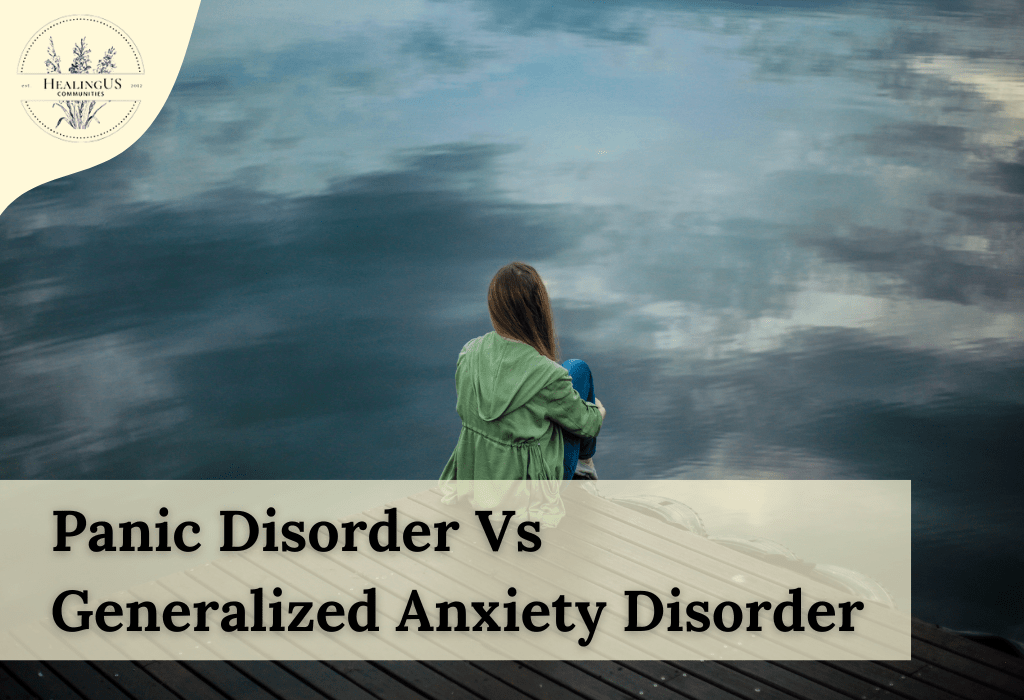Anxiety disorders, affecting millions worldwide, are among the most common mental health challenges. Two types that are often mixed up because of similar symptoms are Panic Disorder (PD) and Generalized Anxiety Disorder (GAD). While both involve feelings of anxiety and fear, they show up in different ways and need different treatment approaches.
It’s important to understand the differences between Panic Disorder vs Generalized Anxiety Disorder to manage them properly. This blog will explain the key differences in their symptoms, causes, and treatment options. Our goal is to help those dealing with these conditions, or anyone supporting someone who is, get a clearer understanding.
What is Panic Disorder (PD)?
Panic Disorder (PD) involves repeated, unexpected panic attacks—sudden bursts of intense fear or discomfort that reach their peak in minutes. These attacks come with physical and emotional symptoms that can make it hard for people to go about their daily lives.
Symptoms of Panic Disorder (PD)
Sudden and overwhelming panic attacks most notably mark Panic Disorder. These attacks are characterized by:
- Physical symptoms include heart palpitations, chest pain, shortness of breath, dizziness, and sweating.
- Emotional symptoms include a sense of impending doom, fear of losing control, or even a fear of dying.
Triggers and Causes
Panic attacks in Panic Disorder can either be triggered by specific situations or occur spontaneously without any obvious cause.
- Situational triggers: Some people may experience panic attacks in response to stressful or feared situations, such as public speaking or flying.
- Spontaneous attacks: Panic attacks often strike without warning, occasionally even waking individuals from sleep.
The causes of Panic Disorder are complex and can involve:
- Genetic predisposition: A family history of anxiety or panic disorders may increase the likelihood of developing Panic Disorder.
- Chronic stress or traumatic experiences: Long-term stress or past trauma can trigger anxiety, leading to the development of Panic Disorder over time.
- Imbalances in brain chemistry: Imbalances in neurotransmitters, which control mood and fear, can contribute to the onset of Panic Disorder.
What is Generalized Anxiety Disorder (GAD)?
Generalized Anxiety Disorder (GAD) is when a person feels constant and overwhelming worry about many everyday things. Unlike Panic Disorder, where fear is focused on specific events, GAD causes anxiety about a wide variety of situations in daily life.
Symptoms of Generalized Anxiety Disorder (GAD)
- Excessive worry: Individuals with GAD experience chronic worry about health, work, finances, and other everyday matters.
- Physical symptoms include muscle tension, fatigue, restlessness, and headaches.
- Emotional symptoms: Difficulty concentrating, irritability, and a constant sense of being overwhelmed are common emotional signs of GAD.
Triggers and Causes
In GAD, the worry comes from different areas of life, not just one thing. For example, someone with GAD might worry about their health one day, their job the next, and then about family problems the day after.
The causes of GAD are likely multifaceted and can include:
- Family history: A predisposition to anxiety can run in families.
- Environmental factors, such as ongoing stress or trauma.
- Chronic stress: Experiencing stress for extended periods can trigger the development of GAD.
Key Differences Between Panic Disorder and GAD
While Panic Disorder vs Generalized Anxiety Disorder are types of anxiety disorders, several key differences distinguish the two:
- Nature of Anxiety
- In Panic Disorder, the anxiety is intense and episodic, manifesting as sudden, acute panic attacks. Occurring suddenly, these attacks can cause significant emotional distress.
- In GAD, the anxiety is more persistent and ongoing. Instead of brief, intense episodes, GAD involves a chronic state of worry that impacts daily life.
- Onset of Symptoms
- Panic Disorder involves sudden and overwhelming panic attacks that come on quickly and unexpectedly.
- GAD develops more gradually and involves a more consistent, long-term feeling of worry that is present most days for months.
- Physical vs. Emotional Focus
- In Panic Disorder, the focus is primarily on the physical symptoms experienced during a panic attack, such as heart palpitations, chest pain, and shortness of breath.
- In GAD, people often have physical symptoms like muscle tension and fatigue, but they also deal with emotional symptoms like irritability and trouble focusing.
- Impact on Daily Life
- For individuals with Panic Disorder, the fear of future panic attacks can cause them to avoid certain places or activities, limiting their daily activities.
- With GAD, the constant worry about various aspects of life can make it difficult to concentrate, make decisions, or enjoy everyday activities.
Diagnosis and Treatment Options
Panic Disorder vs Generalized Anxiety Disorder are diagnosed using guidelines from the DSM-5, which lists specific symptoms, how long they last, and how they affect a person’s life. A psychologist or psychiatrist will review the patient’s history, symptoms, and how these symptoms impact daily life before making a diagnosis.
Treatment for Panic Disorder
- Medications: Antidepressants like SSRIs (Selective Serotonin Reuptake Inhibitors) and anti-anxiety medications such as benzodiazepines are commonly prescribed.
- Therapy: Cognitive-behavioral therapy (CBT) is a helpful treatment for Panic Disorder. It teaches people to recognize and change the thoughts that cause panic attacks. Exposure therapy is also used to slowly introduce people to feared situations, helping them stop avoiding them.
Treatment for GAD
- Medications: SSRIs and SNRIs (Serotonin-Norepinephrine Reuptake Inhibitors) are typically used to treat GAD.
- Therapy: Cognitive-behavioral therapy (CBT) is helpful for GAD by teaching people how to challenge irrational thoughts and control constant worry. Practicing mindfulness and relaxation can lessen the severity of symptoms.
Coping Strategies for Both Conditions
Beyond professional treatment, there are several lifestyle changes and coping strategies that can help manage both Panic Disorder and GAD:
- Exercise: Studies show that regular physical activity helps relieve anxiety and improves overall mood.
- Relaxation techniques: Practices like deep breathing, meditation, and yoga can help calm the mind and reduce anxiety symptoms.
- Healthy diet: Maintaining a balanced diet can boost general health and lower stress levels.
- Support systems: Having a strong support system of family, friends, or a support group can provide emotional support and help individuals cope with their anxiety.
Knowing when to reach out for professional support is crucial. If anxiety is interfering with daily life, it’s crucial to reach out to a healthcare provider for assistance.
FAQs
Q: How do panic disorder vs generalized anxiety disorder differ from each other?
A: The main difference between Panic Disorder (PD) and Generalized Anxiety Disorder (GAD) is their symptoms. GAD involves constant, uncontrollable worrying about many things, often described as “worrying about everything all the time.” PD, on the other hand, causes repeated, unexpected panic attacks—sudden bursts of intense fear with physical symptoms like trouble breathing or a racing heart.
Q: What drug is best for panic disorder?
A: Among the SSRIs approved by the FDA for treating panic disorder, sertraline (Zoloft) and escitalopram work best and have fewer side effects. Panic disorder can also be effectively treated with SSRIs like paroxetine (Paxil) and fluoxetine (Prozac).
Q: What is the first-line treatment for GAD?
A: The main treatment for Generalized Anxiety Disorder (GAD) is antidepressant medications, especially SSRIs and SNRIs. These medicines help control anxiety by balancing certain chemicals, like serotonin and norepinephrine, in the brain.
Q: Can GAD be cured permanently?
A: Generalized Anxiety Disorder (GAD) can be hard to treat over time, and for some people, it may last a long time. However, many people see major improvements with medication or therapy. About 40% of people who have GAD now have excellent mental health, meaning that while a permanent “cure” isn’t always possible, big improvements and good management are achievable.
Conclusion
In summary, Panic Disorder vs Generalized Anxiety Disorder share similarities to anxiety disorders, but they differ significantly in the way they manifest and impact daily life. Panic Disorder involves intense, episodic panic attacks, while GAD is characterized by persistent, long-term worry.
Both conditions are highly treatable, and those suffering from either should not hesitate to seek help. With proper care, including medication, therapy, and lifestyle changes, individuals can manage their symptoms and improve their quality of life.
If you or someone you know is struggling with Panic Disorder or Generalized Anxiety Disorder, don’t hesitate to reach out for support. HealingUS is here to guide you toward understanding and managing these challenges. Start today and take advantage of the available resources.



